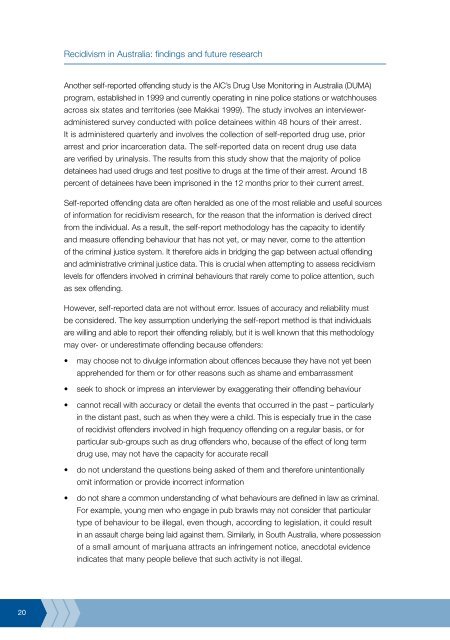Recidivism in Australia : findings and future research - Australian ...
Recidivism in Australia : findings and future research - Australian ...
Recidivism in Australia : findings and future research - Australian ...
You also want an ePaper? Increase the reach of your titles
YUMPU automatically turns print PDFs into web optimized ePapers that Google loves.
20<br />
<strong>Recidivism</strong> <strong>in</strong> <strong>Australia</strong>: f<strong>in</strong>d<strong>in</strong>gs <strong>and</strong> <strong>future</strong> <strong>research</strong><br />
Another self-reported offend<strong>in</strong>g study is the AIC’s Drug Use Monitor<strong>in</strong>g <strong>in</strong> <strong>Australia</strong> (DUMA)<br />
program, established <strong>in</strong> 1999 <strong>and</strong> currently operat<strong>in</strong>g <strong>in</strong> n<strong>in</strong>e police stations or watchhouses<br />
across six states <strong>and</strong> territories (see Makkai 1999). The study <strong>in</strong>volves an <strong>in</strong>tervieweradm<strong>in</strong>istered<br />
survey conducted with police deta<strong>in</strong>ees with<strong>in</strong> 48 hours of their arrest.<br />
It is adm<strong>in</strong>istered quarterly <strong>and</strong> <strong>in</strong>volves the collection of self-reported drug use, prior<br />
arrest <strong>and</strong> prior <strong>in</strong>carceration data. The self-reported data on recent drug use data<br />
are verified by ur<strong>in</strong>alysis. The results from this study show that the majority of police<br />
deta<strong>in</strong>ees had used drugs <strong>and</strong> test positive to drugs at the time of their arrest. Around 18<br />
percent of deta<strong>in</strong>ees have been imprisoned <strong>in</strong> the 12 months prior to their current arrest.<br />
Self-reported offend<strong>in</strong>g data are often heralded as one of the most reliable <strong>and</strong> useful sources<br />
of <strong>in</strong>formation for recidivism <strong>research</strong>, for the reason that the <strong>in</strong>formation is derived direct<br />
from the <strong>in</strong>dividual. As a result, the self-report methodology has the capacity to identify<br />
<strong>and</strong> measure offend<strong>in</strong>g behaviour that has not yet, or may never, come to the attention<br />
of the crim<strong>in</strong>al justice system. It therefore aids <strong>in</strong> bridg<strong>in</strong>g the gap between actual offend<strong>in</strong>g<br />
<strong>and</strong> adm<strong>in</strong>istrative crim<strong>in</strong>al justice data. This is crucial when attempt<strong>in</strong>g to assess recidivism<br />
levels for offenders <strong>in</strong>volved <strong>in</strong> crim<strong>in</strong>al behaviours that rarely come to police attention, such<br />
as sex offend<strong>in</strong>g.<br />
However, self-reported data are not without error. Issues of accuracy <strong>and</strong> reliability must<br />
be considered. The key assumption underly<strong>in</strong>g the self-report method is that <strong>in</strong>dividuals<br />
are will<strong>in</strong>g <strong>and</strong> able to report their offend<strong>in</strong>g reliably, but it is well known that this methodology<br />
may over- or underestimate offend<strong>in</strong>g because offenders:<br />
• may choose not to divulge <strong>in</strong>formation about offences because they have not yet been<br />
apprehended for them or for other reasons such as shame <strong>and</strong> embarrassment<br />
•<br />
•<br />
•<br />
•<br />
seek to shock or impress an <strong>in</strong>terviewer by exaggerat<strong>in</strong>g their offend<strong>in</strong>g behaviour<br />
cannot recall with accuracy or detail the events that occurred <strong>in</strong> the past – particularly<br />
<strong>in</strong> the distant past, such as when they were a child. This is especially true <strong>in</strong> the case<br />
of recidivist offenders <strong>in</strong>volved <strong>in</strong> high frequency offend<strong>in</strong>g on a regular basis, or for<br />
particular sub-groups such as drug offenders who, because of the effect of long term<br />
drug use, may not have the capacity for accurate recall<br />
do not underst<strong>and</strong> the questions be<strong>in</strong>g asked of them <strong>and</strong> therefore un<strong>in</strong>tentionally<br />
omit <strong>in</strong>formation or provide <strong>in</strong>correct <strong>in</strong>formation<br />
do not share a common underst<strong>and</strong><strong>in</strong>g of what behaviours are def<strong>in</strong>ed <strong>in</strong> law as crim<strong>in</strong>al.<br />
For example, young men who engage <strong>in</strong> pub brawls may not consider that particular<br />
type of behaviour to be illegal, even though, accord<strong>in</strong>g to legislation, it could result<br />
<strong>in</strong> an assault charge be<strong>in</strong>g laid aga<strong>in</strong>st them. Similarly, <strong>in</strong> South <strong>Australia</strong>, where possession<br />
of a small amount of marijuana attracts an <strong>in</strong>fr<strong>in</strong>gement notice, anecdotal evidence<br />
<strong>in</strong>dicates that many people believe that such activity is not illegal.















